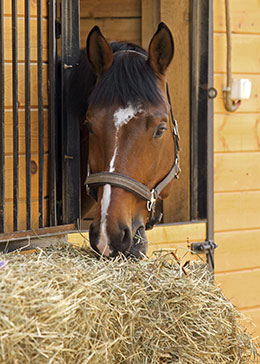- News
- Horse Racing
- Racing Preview
- AQHA Racing Challenge
- Breeding
- Sales
- Quick Stakes Results
- Detail Race Results
- Qualifiers
- Leader Board
- Leading Sires
- Videos
- Auction Leaders
- Q-Racing
Streaming Video

OKLAHOMA CITY, OK—FEBRUARY 5, 2016—The spread of EHV-1 at New Mexico and Arizona racetracks is a serious concern to horsemen. Take an opportunity to learn how to prevent the spread of this disease and help get it stopped.
Here are tips, courtesy of OQHRA:
THE TEMPERATURE OF THE HORSE IS THE KEY. . . .Horses frequently do not show any signs of the virus at first, only a elevated temperature. Experts say that horses will not, or are not "shedding the virus" unless they are running a temperature, but once they get a temp and they start shedding the virus through blowing and nasal secretions, it is EXTREMELY CONTAGIOUS.
We need your help and ask that you immediately implement a program to check those temperatures TWICE every day (morning and evening). Horses can be long term carriers of this disease and as we see random cases popping up across the country, we know we are in the season of the year when this disease is most likely to show up. Our goal is to identify and somehow isolate any sick horse with a temp at home or on the track, and we will have a much better chance of containing the virus and not letting it spread.
We are asking every owner and every trainer to immediately start a program of taking temperature of every horse twice a day... even though you think your horses haven't been anywhere to get the virus. If everyone with horses will start TODAY checking or logging temperatures we will have a much better ability to keep this virus from spreading. Especially critical is monitoring any horses that plan on coming into the racetrack as well as any other horses stabled with horses coming to the racetrack. Owners please ask your trainers to implement this practice with your horses, trainers please get this in your routine immediately.
If you have a horse that has a temperature of 101 or greater, immediately isolate that horse and evaluate where it has been, what physical activity it has had in the last 12 hours, whether or not it is eating, etc. That horse should be rechecked in a couple hours, and if the temp is still 101. or higher you should immediately contact your veterinarian. Any temperature above 101 is a possible sign, and the concern if that if a temperature is over 101.5 the horse would be contagious and probably shedding the disease. Not all horses will develop neurologic symptoms but all horses tested positive for the virus remain contagious due to the shedding even after the temperature has run its course. Please do not take a chance if you have a sick horse, the Oklahoma Department of Ag has said they will work with us to provide immediate testing results and you are better safe than sorry to have your vet test any horse that is showing a temperature at this time.
The EHV medical experts suggest you use good common sense and watch each horse closely to see if it is a little off feed, lethargic, runny nose, etc. and most importantly keep a very close eye on temperatures. Additionally, use good common sense in not subjecting your horses to contamination with humans or horses that may have been in contact with infected horses anywhere. For example, when coming back from the track and a horse is blowing, it can spread any potential virus about 30 feet or so outside, and in a barn it might spread further or have more ability to contaminate more horses. When possible cool out horses that have just worked in the out of doors and away from other horses as much as possible to minimize the contamination between horse horses in the barn while the horse is still blowing.
For more information, find resources here:
- The Facts About Equine Herpes Virus (EHV-1)
- Biosecurity Tips
- Biosecurity Tips in Espanol
- Disinfection Protocol

 Newsletters
Newsletters Facebook
Facebook